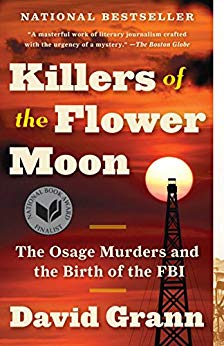

This article is an excerpt from the Shortform summary of "Killers of the Flower Moon" by David Grann. Shortform has the world's best summaries of books you should be reading.
Like this article? Sign up for a free trial here .
What was the Osage Reign of Terror? Why did it start, and how did it end?
The Osage Reign of Terror occurred in the 1920s in Oklahoma. It was defined by a series of murders that turned out to be a conspiracy designed to steal the wealth of the Osage tribe.
Continue reading to learn about this dark episode in American history.
What Was the Osage Reign of Terror?
The five-year-long Osage Reign of Terror began in May 1921 with the discovery of the body of a murdered Osage woman named Anna Brown. Anna had been married to a white man, as were her sisters, Mollie Burkhart and Rita Smith.
In these parts of rural Oklahoma in the 1920s, elements of the frontier justice system still remained. Police forces were not yet fully professionalized, so ordinary citizens still assumed some of the responsibilities of criminal justice, including the investigation of evidence and even the pursuit of suspects.
One of the remaining vestiges of this rough-and-tumble approach to criminal justice was the citizens inquest, in which members of the community would visit the scene of a homicide with the county coroner to collect evidence and record any witness testimony. Anna Brown’s inquest and on-the-scene autopsy were gruesome, hasty, unprofessional, unscientific, and amateurish even by the standards of the day, with no proper protocol or procedure followed and a crowd of onlookers (including Anna’s family) witnessing the whole grisly spectacle.
This was how law enforcement and criminal justice were still practiced in remote parts of the American West, even as late as the 1920s. Many rural sheriffs were not professionally trained law enforcement officials, but were instead rugged frontiersmen, so-called “lawmen” who were often corrupt, violent, and connected to criminal elements within their jurisdiction. Private investigators were not much better. Many agents of the famed Pinkerton Detective Agency were criminals themselves, with no respect for people’s civil liberties or proper protocol in criminal investigations. Many, similarly, used their position to extort and terrorize the very people they were meant to be protecting. They were not equipped to deal with anything like the Osage Reign of Terror.
Osage Reign of Terror: The Motive
As the death toll rose and more Osage were killed, it became clear that state and local law enforcement was either too incompetent or corrupt to restore order and safety in Osage County. One special investigator or private detective after another would be found either taking bribes or participating in illicit criminal activities. To make things worse, red herrings and false leads repeatedly hampered the investigation, as the conspirators worked to manufacture evidence and throw the investigators off. By July 1921, the local authorities wrapped up the investigation, concluding that Anna Brown had been murdered by “parties unknown.”
Through a combination of undercover sleuthing, combing through financial records, and extracting confessions from key witnesses, the agents identified the businessman, power broker, and self-styled “True Friend of the Osage” William Hale as the mastermind behind the Osage Reign of Terror. Hale had powerful business and political connections and supported the establishment of charities, schools, and hospitals for the Osage. Hale was more than just any local grandee, moreover—he was the uncle of Ernest Burkhart, Mollie Burkhart’s husband. He had been at Anna Brown’s funeral and even vowed to the family that he would seek justice for Anna.
The Bureau agents discovered that Ernest Burkhart and his brother, Bryan, had been willing and active accomplices in their uncle’s murderous conspiracy—Ernest Burkhart had been a party to the murder of his wife’s sisters. In piecing together the puzzle, White’s team saw that the motive for all the murders was simple: profit.
Osage Reign of Terror: The Legacy
In response to the Osage Reign of Terror, the Osage Tribal Council persuaded Congress to pass a law barring anyone who was not at least half-Osage from inheriting a headright, removing some of the incentives for whites to murder them. Anna divorced Ernest shortly after he was sent to prison, revolted and outraged by what he and his family had done to her loved ones. She remarried and was restored to full financial competence (freeing her from the corrupt guardianship system), before passing away in 1937.
Tom White became the warden of the U.S. penitentiary at Leavenworth, Kansas, where he was known for his relatively humane treatment of inmates and support for a more rehabilitative approach to criminal justice. In 1931, he was shot in the arm by a gang of inmates attempting to escape. Although he survived, he permanently lost the use of his left arm. After retiring in 1951, White attempted to publicize his role in cracking the Osage case but was coolly rebuffed by the self-aggrandizing Hoover, who had little use for his former star agent. After failing to find a publisher for his memoirs, White died in 1971, an obscure and largely forgotten figure.
Today, much of the wealth of the Osage has evaporated, as oil prices plunged beginning in the 1930s, thanks to over-drilling and the discovery of new petroleum sources elsewhere in the world. As early as 1931, the value of an Osage annual headright had plummeted to $800. In 2012, a sale of three leases went for less than $25,000. The former boomtowns had turned into decaying and desolate ghost towns.
Although the Osage Reign of Terror took place nearly a century ago, its memory haunts the Osage today. The archival research by historians today strongly suggests that Hale and his gang were not the sole perpetrators of the Osage Reign of Terror. There were likely many more perpetrators and victims—for whom justice was never done. Some accounts place the true death toll in the scores, and possibly in the hundreds.
The Osage community has managed to persevere—the tribe now operates several casinos that generate tens of millions of dollars annually and, in 2011, received a $380 million settlement from the U.S. government in compensation for the decades of fraud and abuse. The Osage Nation has its own tribal government within Oklahoma and operates its own health, education, and welfare programs. And although the oil money is mostly gone, the old fear that the white man’s money would erase their identity has not come to pass, and the tribe proudly maintains its cultural heritage.
But the past can never be erased and the pain can never be forgotten. The fields and prairies of Osage County are forever soaked in blood.
The Osage Reign of Terror had long-lasting and generational consequences. In addition to the many people who lost their lives and families, the Osage Reign of Terror was an injustice that greatly affected the entire Osage Tribe.

———End of Preview———
Like what you just read? Read the rest of the world's best summary of David Grann's "Killers of the Flower Moon" at Shortform .
Here's what you'll find in our full Killers of the Flower Moon summary :
- How the Osage tribe had vast oil wealth, but had it seized by their murderous neighbors
- The brutal and unresolved murders of Osage Native Americans
- The complicated history of the FBI in profiting from the Osage murders






